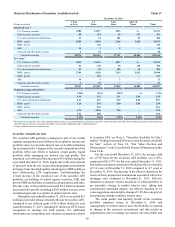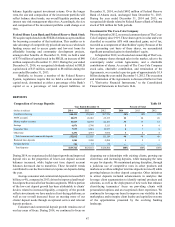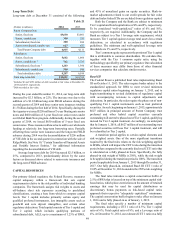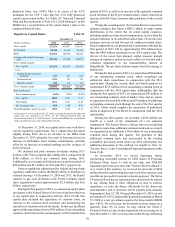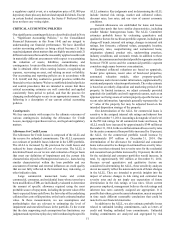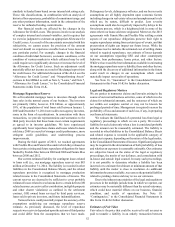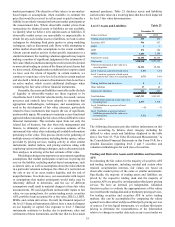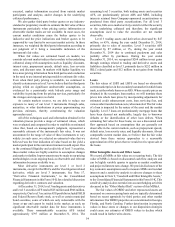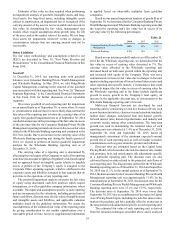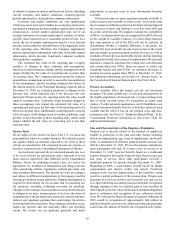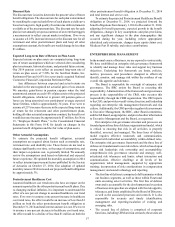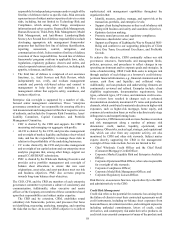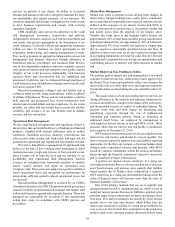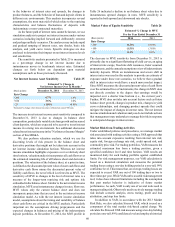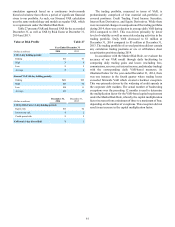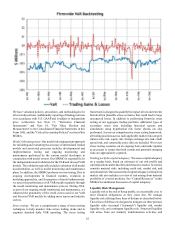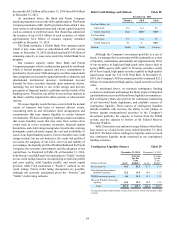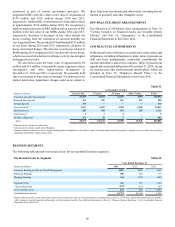SunTrust 2014 Annual Report Download - page 79
Download and view the complete annual report
Please find page 79 of the 2014 SunTrust annual report below. You can navigate through the pages in the report by either clicking on the pages listed below, or by using the keyword search tool below to find specific information within the annual report.56
in relation to numerous market and historical factors, including
current economic and market conditions, company-specific
growth opportunities, and guideline company information.
Economic and market conditions can vary significantly
which may cause increased volatility in a company's stock price,
resulting in a temporary decline in market capitalization. In those
circumstances, current market capitalization may not be an
accurate indication of a market participant's estimate of entity-
specific value measured over a reasonable period of time. As a
result, the use of market capitalization may be a less relevant
measure in assessing the reasonableness of the aggregate value
of the reporting units. Therefore, the Company supplements
market capitalization information with other observable market
information, which provides benchmark valuation multiples
from guideline companies.
The estimated fair value of the reporting unit is highly
sensitive to changes in these estimates and assumptions;
therefore, in some instances, changes in these assumptions could
impact whether the fair value of a reporting unit is greater than
its carrying value. The Company performs sensitivity analyses
around these assumptions in order to assess the reasonableness
of the assumptions, and the resulting estimated fair values. In
the interim analysis of the Wholesale Banking reporting unit at
December 31, 2014, we evaluated sensitivity to changes in the
discount rate, which indicated that if the discount rate was
increased 50 basis points, the reporting unit's fair value would
equal its carrying value. Ultimately, future potential changes in
these assumptions may impact the estimated fair value of a
reporting unit and cause the fair value of the reporting unit to be
below its carrying value. Additionally, a reporting unit's carrying
value of equity could change based on market conditions, asset
growth, or the risk profile of those reporting units, which could
impact whether the fair value of a reporting unit is less than
carrying value.
Income Taxes
We are subject to the income tax laws of the U.S., its states and
municipalities where we conduct business. We estimate income
tax expense based on amounts expected to be owed to these
various tax jurisdictions. The estimated income tax expense or
benefit is reported in the Consolidated Statements of Income.
Accrued taxes represent the net estimated amount due to or
to be received from tax jurisdictions either currently or in the
future and are reported in other liabilities on the Consolidated
Balance Sheets. In estimating accrued taxes, we assess the
appropriate tax treatment of transactions and filing positions
after considering statutes, regulations, judicial precedent, and
other pertinent information. The income tax laws are complex
and subject to different interpretations by the taxpayer and the
relevant government taxing authorities. Significant judgment is
required in determining the tax accruals and in evaluating our
tax positions, including evaluating uncertain tax positions.
Changes in the estimate of accrued taxes occur periodically due
to changes in tax rates, interpretations of tax laws, the status of
examinations by the tax authorities, and newly enacted statutory,
judicial, and regulatory guidance that could impact the relative
merits and risks of tax positions. These changes, when they occur,
impact tax expense and can materially affect our operating
results. We review our tax positions quarterly and make
adjustments to accrued taxes as new information becomes
available.
Deferred income tax assets represent amounts available to
reduce income taxes payable in future years. Such assets arise
due to temporary differences between the financial reporting and
the tax bases of assets and liabilities, as well as from NOL and
tax credit carryforwards. We regularly evaluate the realizability
of DTAs. A valuation allowance is recognized for a DTA if, based
on the weight of available evidence, it is more-likely-than-not
that some portion or all of the DTA will not be realized. In
determining whether a valuation allowance is necessary, we
consider the level of taxable income in prior years to the extent
that carrybacks are permitted under current tax laws, as well as
estimates of future pre-tax and taxable income and tax planning
strategies that would, if necessary, be implemented. We currently
maintain a valuation allowance for certain state carryforwards
and certain other state DTAs. Since we expect to realize our
remaining federal and state DTAs, no valuation allowance is
deemed necessary against these DTAs at December 31, 2014.
For additional information, refer to Note 14, “Income Taxes,” to
the Consolidated Financial Statements in this Form 10-K.
Pension Accounting
Several variables affect the annual cost for our retirement
programs. The main variables are: (1) size and characteristics of
the eligible population, (2) discount rate, (3) expected long-term
rate of return on plan assets, (4) recognition of actual asset
returns, (5) other actuarial assumptions, and (6) healthcare cost
for post-retirement benefits. Below is a brief description of each
variable and the effect it has on our pension costs and post-
retirement costs. See Note 15, “Employee Benefit Plans,” to the
Consolidated Financial Statements in this Form 10-K for
additional information.
Size and Characteristics of the Employee Population
Pension cost is directly related to the number of employees
eligible to participate in the plan and other factors including
historical compensation, age, years of employment, and benefit
terms. A curtailment of all future pension benefit accruals was
effective December 31, 2011. Prior to the pension curtailment,
most participants who had 20 or more years of service as of
December 31, 2007 received benefits based on a traditional
pension formula with benefits linked to their final average pay
and years of service. Most other participants received a
traditional pension for periods through December 31, 2007.
Beginning in 2008, a cash balance benefit based on annual
compensation and interest credits was earned. Continued
changes in the size and characteristics of the workforce could
result in a partial settlement of the pension plan. If lump sum
payments in a year exceed the total of interest cost and service
cost, then settlement accounting requires immediate recognition
through earnings of any net actuarial gain or loss recorded in
AOCI based on the fair value of plan assets and plan obligations
prior to settlement, and recognition of any settlement related
costs. We estimate the financial impact of a partial settlement in
2015 would be recognition of approximately $40 million in
additional benefit cost; however, additional lump sum payments
could cause the amount of benefit cost recognized to be higher.


